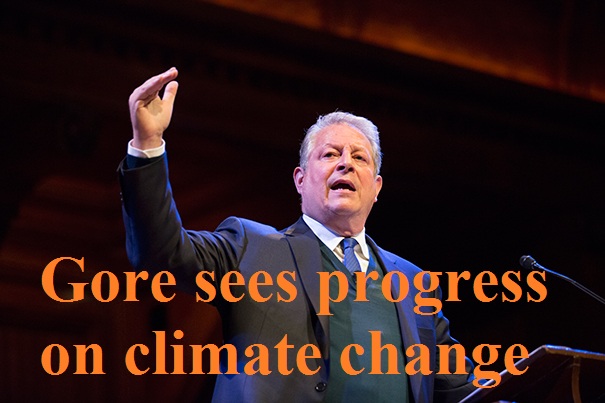Al Gore brought a measurement of environmental change hopefulness to Harvard, puncturing the average anguish and-fate story with the perspective that things are at last improving and that the pace of that change has started to quicken quickly.
Addressing a full house Thursday at 1,000-seat Sanders Theater, the previous VP recognized that atmosphere issues still midget the rising arrangements. The planet keeps on getting more blazing, tempests more grounded, and dry spells longer. A year ago was the hottest on record, and January and February of this current year were both record-breakers, Gore called attention to. What's more, the pattern is for more warmth, since we keep on pumping enough nursery gas into the climate consistently to level with the warmth vitality of 400,000 Hiroshima-sized bombs.
The impacts are all around, Gore noted, refering to New York's waiting repairs from Superstorm Sandy of 2012, and in addition expanded flooding in Miami, splashing downpours in Houston, and a four-year dry season in Syria that has executed 80 percent of the nation's domesticated animals, brought about 60 percent of its homesteads to come up short, and drove 1.5 million exiles to its urban communities.
However, Gore refered to the appropriation of renewable vitality — for the most part wind and sunlight based force — as purpose behind trust. Renewable plants are being worked at a fast pace, making up 90 percent of new vitality limit comprehensively. Those establishments have as of now had any kind of effect, he said, with worldwide nursery gas outflows holding enduring the previous two years.
One squeezing question, Gore yielded, is whether positive patterns will move sufficiently quick to fight off the most exceedingly awful anticipated impacts. Fossil energizes still give more than 80 percent of worldwide force. His trust lies in late indications of exponential development in new innovation.
"We are winning this battle," he said. "We are not moving sufficiently quick, but rather we are going to win it."
Sun based and wind establishments have exceeded even late expectations, he said. Wind power gauges for 2010 made in 2000 were surpassed by 14 times. Sun powered appraisals for 2010 made in 2002 were surpassed two years prior by 58 times, and a year ago by 68 times, he said.
Blood compared the reception of renewables to that of the cellphone. At the point when the cellphone business was simply beginning in the mid 1980s, an expert to AT&T anticipated the organization would have the capacity to offer 900,000 telephones a year by 2000. Rather, 900,000 were sold in the initial three days of the year.
The development of the business, Gore said, has profited from a mix of quickly enhancing innovation and interest — on account of cellphones, for an approach to jump exorbitant, unwieldy base of phone lines. Today, cellphones are regular all through the creating scene.
Renewable innovation, Gore said, is ready to exploit a comparable element. As innovation keeps on enhancing, the expense of establishments ought to drop. What's more, he said, the potential interest for spotless, appropriated, off-lattice force is colossal, with 1.5 billion individuals not associated with an electric matrix and billions more with problematic framework based force
Violence's discussion was supported by the Harvard Global Institute, which was propelled in October to encourage interdisciplinary joint effort on extensive issues confronting the world today, including environmental change. Different patrons were the Harvard China Project and the John A. Paulson School of Engineering and Applied Sciences.
Behind the upsurge in development of renewable-force establishments is a moving monetary reality, Gore said. Financial specialists and force organizations are developing mindful about new fossil fuel plants, to the degree that no new coal plants were inherent the United States a year ago. The fundamental reality, Gore said, is that there is $22 trillion worth of fossil fuel assets that can't be smoldered, leaving stranded resources on monetary records. That advancement, he said, makes fossil-fuel firms progressively poor ventures, something he encouraged Harvard to consider as it deals with its gift.
Another reason for positive thinking, Gore said, is the developing association on atmosphere between the world's two biggest emitters — China and the United States. The two countries reported a noteworthy two-sided understanding in 2014, which China took after a year ago with the declaration of a top and-exchange carbon outflows framework.
"I'm extremely energized," he said. "The response to the subject of 'Will we change?' is liable to be yes."
Source: http://goo.gl/HVcePz
Image source: Harvard

Blogger Comment
Facebook Comment